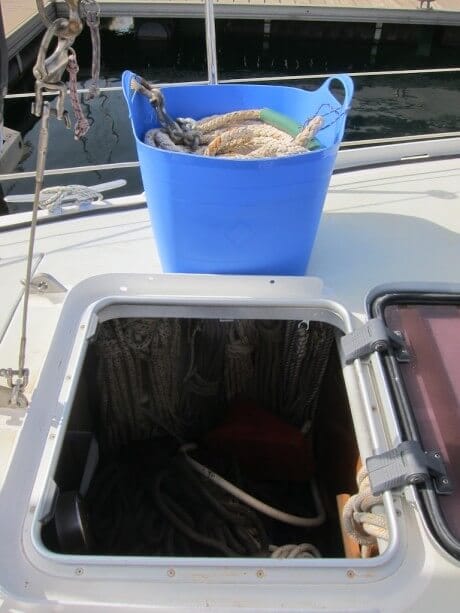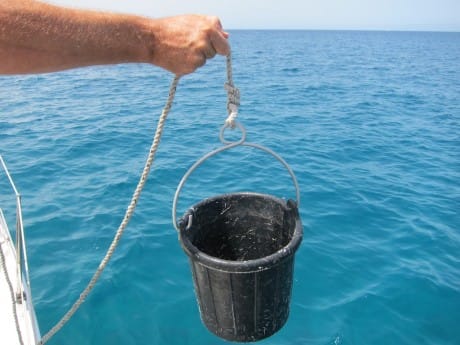
Just made for the job
One refreshing thing about Spain is that it is still a country where people carry out many of their own repairs. Evidence of this can be seen in the number of ironmongers (ferreterias) that still exist in even relatively minor towns, Aladdin’s caves filled with every conceivable item for some old fashioned DIY from the tiniest screw to a cement mixer.
The same is true of the chandleries, catering as they do not just to the yacht and power boat fleet, but also the huge sport and commercial fishing market. An extraordinarily wide range of useful material is on display, and whilst much of it is oversized or unsuited to the leisure end of the market, every now and again there are really useful crossover items that fit our world, too. Which is just as well, because more and more we find that things sold as ‘yachting’ items are overpriced and poor quality.
See What The Working Guys Are Using
I’d seen a number of fishing boats in the local harbours with gear stowed in sturdy looking plastic trugs (as gardeners call them) of varying sizes, and thought they looked like they’d have a multitude of uses aboard Pèlerin. So I set about tracking them down, eventually finding a range of different sizes in the local fishermen’s co-op store. And they’ve proved to be perfect for a number of uses already, such as doing our laundry, storing all manner of gear, and my current favourite, stowing our kedge warp.
This is a perennial hassle aboard most boats, as the warp tends to get in a tangle the second you look at it , or as you flake it down into the dinghy for rowing out with the anchor. I’ve tried most things at times, from a large ‘loop’ with lashings, to coiling it down in an old sail bag, but nothing has proved perfect – yet. But this comes close, I think.
The trug in the picture easily holds 75 metres of 16mm nylon octoplait, spliced into 10m of 10mm chain. This is our third and lightest cable, and is really only aimed at use with our stern anchor, but it still weighs somewhere in the region of 75lbs., more than enough to make my back groan when lifting it. We try and stow all of such gear below, much of it in our forward stowage compartment, and the square section of the trug we chose is just the right size to pass through the deck hatch.
Using the power winch in the cockpit and our over-length spinnaker halyard attached to a lifting becket on the two solidly mounted handles, it’s a cinch to lift in or out of the hatch or the dinghy. With the chain stowed at the bottom (and the end tied to one of the handles) and the warp flaked down neatly, it’s ideal for attaching the kedge (usually a Fortress FX-23) and, with the rope end made fast aboard, rowing it out to be set.
Cost of the trug – less than $10. Satisfaction – complete.
Low vs. High Tech
There are, of course, higher tech ways of doing this, such as the excellent German-made Easyroll line drums that come in a variety of sizes and grades of warp – well made, but pricey. We have a custom made drum that bolts to the foredeck for our second cable (80m 20mm nylon octoplait spliced to 30m of 10mm chain), with its own handle for release and retrieval, which is excellent in use, but takes time to set up. But for most general purpose uses we reckon our new, simple, cheap system is as good as any.

Bombproof buckets
Amongst other really good Spanish made items that we can thoroughly recommend are their fishermen’s buckets. These are made from a reinforced rubber compound, which is soft so that they don’t scratch or mark the boat – or us. They have really solid handles with a central eye for attaching a lanyard and are just the right size for hoisting water from over the side, even under way – not too much weight or drag to pull some poor soul over the side. And they’re cheap (at less than $8) and completely unbreakable.
More and more we find ourselves wandering off in the direction of hardware stores rather than chandleries when we’re looking for a solution to some unanswered need – maybe you’ve found some useful items, too, in this way. Let us know with a comment.
lol!
I am a spanish sailing boat. Off course I have both things, and use them for exactly the same porposes!!
Thanks for all the articles,
Kindest Regards from Barcelona.
Hi Kenneth
Glad you like them – thanks!
Colin
LOL. My current boat (a custom steel design built in France) came with a large ‘trug’ which had been used for washing in the Carrib and which I converted for storing the secondary rode. (Great minds think alike.) My previous boat (a Great Dane 28, built in Denmark but from Sweden) came with an identical bucket with the eye. I’ve seen similar buckets for sale in the US (at stores specializing in farm equipment) and labeled as ‘horse feeding buckets’ – but they don’t have the eye. (Still, I bought one anyway – you’ve got to have more than one really good bucket). Also got ‘vet wrap’ in the same store and put it in the first aid kit (for myself, I didn’t have the ship’s cat then).
It’s always worthwhile (and fun) looking through marine supply stores which specialize in selling to commercial fishing boats. The most I’ve seen have been in New Bedford-Fairhaven.
PS: I found a similar gardener’s bucket in the trash in New York City and converted it into a litter box for the ship’s cat. The sides are a lot higher than your typical litter box and therefore it would take a 90 degree knockdown to cause the litter to spill out of the box. Also, it’s rubber construction meant that it could be more easily made to fit tightly in a designated spot. I cut out an opening for the cat to enter and exit. So far it has worked out well – and it was free.
Hi Jerry
It certainly pays to visit the commercial guys stores, not just because there’s a load of good strong, simple kit that’s on offer that can do the job for us – the prices are right, too!
Best wishes
Colin
Those rubber buckets are a good idea, thanks! They’re common in horse barns. Look in a tack supply catalog…
Colin, We have 2 trugs (never knew the name) and find them very handy for a variety of things, but difficult to store when not in use. Then we looked at our outboard and threw it over the top and secured it. Not very scenic if the yellow bucket is outside, but the green on the outside blends in fine. Also protects the outboard a bit. We have tried the smaller black buckets similar to the one in your picture that we got at a US farm store and they left lots of black marks, so test it out if possible. Not all are made alike. Dick Stevenson, s/v Alchemy
Hi Colin
if we look beyond the ‘normal’ suppliers, there are loads of good items on offer. Horses – of course, they’d probably eat anything else…
Colin
Hi Dick
trug – great name, too, eh?
The rubber buckets we have don’t mark at all, and believe me they would on our non-slip – everything does.
Best wishes
Colin
“See what the working guys are using.” Exactly.
The local welder welds eyes onto my bucket handles.
Great idea and certainly looks worthy of carrying the weight. Do you have any suggestions on where we might find these stateside? Will google now and let you know of my findings..
Ernie
s/v Iemanja
Btv
I found them at where else….tubtrugs.com
Also at Hamilton marine in Maine but their sizes are limited..
Ernie
Hi Ernie,
Thanks for the sleuth job.
Hi Colin,
I have 2 of the black buckets, and use trugs at home for logs. On the washing front, I use alarge BDH jar {yellow screw top flare box} for washing, fill it up in the morning, tie on deck and the boats motion does all the work…
Paul
Hi Paul
Who needs a washing machine? Great idea.
Colin
I have a2 trugs, and another bucket cut down from one on a plasterers discard pile. I cut off the rim, so that the remaining height would fit in my cockpit locker, then slipped the taper of the cutoff rim over the taper of the shortened bucket, and drilled a pair of holes through both layers for a rope handle. Good, robust, recycled, cheap.
Notquite on topic, but a similar theme…
I have found dairy farmers boots (mine are by Skellerup NZ) excellent on board yachts. Dairy farmers have the same requirements for comfort, warmth (mine have a very thick inner sole) and non slip soles in slippery wet conditions. They are however a bit heavy, and might need to be jettisoned if you fall overboard…
Simon
Hi Simon
Re the boots, Lou has a pair like those, a relic from her days offshore on rigs, and if they were my size she wouldn’t have them any more….
But you’re right, you’d swim like a brick in the things, so it’s a good job you can kick them off.
Colin
I keep a bucket permanently mounted in a cockpit locker, open face up. The fueling funnel and rags live in it, so when I’ve finished fueling, I just drop the funnel and rags into it and forget about it. No drips or seeps – all fuel leftovers stay in the bucket.
Hi Billy
A very good point, and I wish more people took more trouble when they fill up – far too often there’s diesel everywhere, and as you know, a little goes a long way.
Best wishes
Colin
Colin, I vividly recall my experience in the Galapagos Islands (part of Ecuador, so deep Spanish roots) on discovering the nineteenth strand of the forestay popped away from the swage at the top, a few days prior to setting sail for the Marquesas Islands, just 3200nm westward!!
It was a harrowing discovery (covered in more detail in my book) at that point as we were due to clear Puerto Aroyo within 72 hours and a solution was needed quickly.
I found my roadside engineer, Miguel, who understood exactly what needed to be done and proceeded to fashion and weld on a beautiful extended swage (additional 10cm) which he pressed on with his massive old hydraulic press. When he had finished the weld seam was mirror polished and invisible.
He completed the task in under 48 hrs. and asked for a bill of USD84 – amazing work. I happily paid up and also bought him a carton of beer, of which we drank some – friends for life!
His work never gave a moment of worry all the way to Papeete where I had a new forestay flown in. It no doubt would have been good to New Zealand, but approaching southern seas I didn’t wish to push my luck any further. That forestay is still coiled up and tucked under the foam mattress in the aft cabin – just in case!
Hi Vince
I’ll bet that all of us have, at one time or another, had our bacon saved by a roadside mechanic – I know I have. Whilst these guys don’t tend to have a degree in engineering, nothing phases them, and what they lack in formal education they more than make up for with skill and ingenuity – fantastic people.
Kind regards
Colin